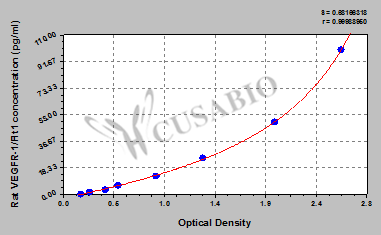The rat VEGFR-1 ELISA Kit is engineered for accurate measurement of rat VEGFR-1 levels from samples including serum, plasma, or tissue homogenates. It uses the Sandwich-ELISA mechanism in combination with the enzyme-substrate chromogenic reaction to measure the VEGFR-1 content in the sample. The color intensity is positively correlated with VEGFR-1 content in the sample. The VEGFR-1 concentration can be calculated according to the standard curve. This kit is tested with high sensitivity, strong specificity, good linearity, high precision and recovery, as well as lot-to-lot consistency.
VEGFR-1, also called Flt-1, is the exclusive VEGFR present on the surface of monocytes and mediates a chemotactic response to VEGF-A and tissue factor induction. In myeloid cells, VEGFR-1 mediates monocyte migration and has a regulatory role in the development of inflammatory diseases such as rheumatoid arthritis and arteriosclerosis. In vascular smooth muscle cells (SMCs), VEGFR-1 is inducibly expressed by vascular injury and participates in neointimal development. VEGFR-1 expression has frequently been detected in melanoma and is also found in other cancer types. Upon activation by VEGF-A or PlGF, VEGFR-1 promotes cell survival, migration, invasiveness, and chemoresistance of melanoma cells.






